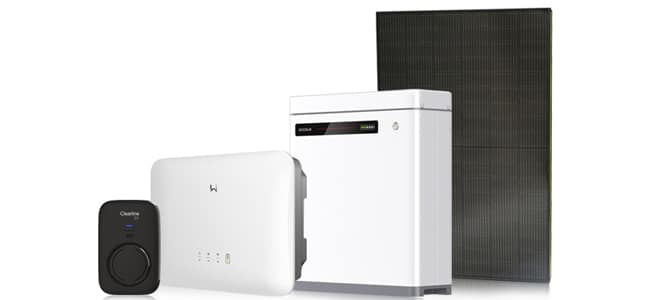Why including solar roof tiles, a solar inverter and battery storage help future-proof your self-build project

When planning a self-build project, the design stage is the best time to consider installing energy saving products such as solar roof tiles, a solar inverter and battery storage. The individual units and their connecting cables can then be incorporated into the build during construction, rather than retrofitting at a later stage.
A fully integrated solar capture and storage system offers several benefits, including:
- Significantly reducing the properties overall energy costs
- Improving the building’s energy performance certificate (EPC) rating (particularly advantageous when potentially selling the house or renting out to tenants)
- Future-proofing the home by reducing the impact of energy price increases
- Will reduce running costs of an air-source heat pump
- Reducing your carbon footprint by taking advantage of a renewable, natural energy source
- Supporting a greener, more sustainable lifestyle
A report published in January 2024 by The House of Commons Library, showed that in April 2022, typical household energy bills increased by 54% and a further 27% in October of the same year (1). Additionally, the news carries frequent reports on how the world’s situation with conflicts and political tension can affect energy supplies, causing continued uncertainty over energy prices. Using solar capture (also known as photovoltaic or ‘PV’ for short) and battery storage technology to provide your own, clean electricity makes financial sense as well as helping to reduce your impact on the environment.
Installing a renewable energy system to generate your own electricity from the sun can help ease uncertainty of future energy price increases while helping you to ‘do your bit’ for the environment. The addition of solar electricity generation to your home is classed as an ‘energy efficiency measure’ and can raise the EPC (Energy Performance Certificate) rating of your property, potentially increasing its market value – which the use of solar roof tiles and complementary technologies can also help to achieve.
Why use solar roof tiles?
Conventional solar panels are installed above the roof tiles and can look unsightly. The voids below the panels can often become occupied by nesting birds which can cause issues with blocked gutters as well as having an impact on the efficiency of the panel. Fully integrated solar roof tiles which form part of the roof covering, are rapidly gaining popularity. These use the same PV technology as solar panels to convert sunlight into electricity and are seamlessly integrated into the roof covering giving the installation a much more aesthetically pleasing finish.
The benefits of solar batteries
When the energy needs of your home are lower, for example, when you are at work or away during the day, your solar roof tiles can produce more electricity than is needed. By adding a solar battery, the system is able to store this ‘excess’ energy and make it available to the home later when grid electricity is at its most costly.
An added benefit of a solar battery is its ability to be used as an emergency back-up in the event of a power cut. A back-up enabled system uses the inverter to switch to the solar battery to maintain electricity supply to a property in event of a power outage.
During the hours of darkness when your PV system produces no electricity, it is possible to charge a solar battery using cheaper, off-peak electricity supplied by the grid ready for use the next day. Using a solar battery in this way maximises its benefit, particularly in the winter months when less solar energy from the sun is available.
The function of a solar inverter
The power generated by solar panels must be converted to usable, household electricity and to do this, the system requires an inverter. This is effectively the brains of the PV system and is used to convert the direct current (DC) power from the solar tiles into alternating current (AC) which it then supplies to the home.
A PV system with the facility to provide back-up power uses the inverter to rapidly switch the electricity supply from the grid to the solar battery.
The Marley SolarTile® and battery storage system
Marley can supply the individual solar capture and storage components as well as a full system. By installing a complete Marley PV solution, compatibility of each component is assured, giving you peace of mind in knowing that each part of the system will work together to make the most of renewable solar energy. The Marley renewable energy system solutions include solar roof tiles, solar batteries, solar inverters and an electric vehicle charger.
Contact us here to find out more about Marley’s renewable energy system solutions and how they can support your next self-build project.
(1) https://commonslibrary.parliament.uk/research-briefings/cbp-9491/